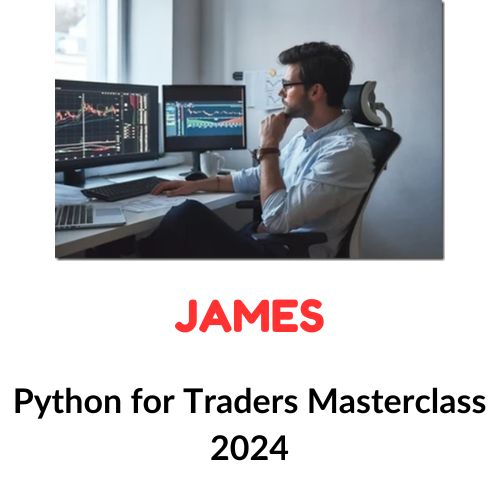Python for Traders Masterclass 2024 DownloadPython for Traders Masterclass 2024 | Size: 484 MBAbout Course:The Python for Traders Masterclass8 Modules4 Projects105 Lessons248 Code Examples34 Hours of ContentModule 1: Introduction1.1. Welcome to the Python for Traders Masterclass(2:14)PREVIEW1.2. Why learn to code as a trader?(7:15)PREVIEW1.3. Why should traders learn Python?(4:23)PREVIEW1.4. What will I gain from this course?PREVIEW1.5. What topics will be covered?PREVIEW1.6. Who is the intended audience for this course?PREVIEW1.7. How much finance knowledge do I need?(1:40)PREVIEW1.8. How much coding knowledge do I need?(1:37)PREVIEW1.9. Placement Quiz: Am I a good fit for this course?PREVIEW1.10. Module QuizSTARTModule 2: Python Fundamentals for Finance2.1. Python Installation and SetupSTART2.2. Running Python CodeSTART2.3. Basic Python(26:34)START2.4. Intermediate Python(5:07)START2.5. Advanced PythonSTART2.6. Data Science in PythonSTART2.7. Key library: PandasSTART2.8. Key library: NumPySTART2.9. Key library: MatplotlibSTART2.10. Key library: StatsmodelsSTART2.11. Key library: Scikit-learnSTARTModule 3: Working with Financial Data3.1. Introduction to Financial Data: Time Series and Cross-SectionsSTART3.2. Data Acquisition and Cleaning(18:09)START3.3. Time Series Analysis(13:38)START3.4. Understanding Stationarity(11:55)START3.5. Time Series ForecastingSTART3.6. Exploratory Data AnalysisSTART3.7. Section summarySTARTModule 4: How to Code and Backtest a Trading Algorithm4.1. So what is a trading algorithm?START4.2. Algorithm Design PrinciplesSTART4.3. Data Management Module(15:12)START4.4. Signal Generation Module(15:12)START4.5. Risk Management Module(10:58)START4.6. Trade Execution Module(10:27)START4.7. Portfolio Management Module(11:05)START4.8. Backtesting BasicsSTART4.9. Backtesting SoftwareSTART4.10. Advanced Backtesting TechniquesSTART4.11. Optimization and Parameter TuningSTARTProject 1: Research & Backtest a Realistic Trading AlgorithmProject Overview(6:57)STARTStep 1: Getting Started on QuantConnect(6:53)STARTStep 2: Formulate a StrategySTARTSolution: Formulate a StrategySTARTStep 3: Develop the AlgorithmSTARTSolution: Develop the AlgorithmSTARTStep 4: Run a Backtesting AnalysisSTARTSolution 4: Run a Backtesting AnalysisSTARTProject SummarySTARTModule 5: Automated Data Collection, Cleaning, and Storage5.1. Sourcing financial data(5:38)START5.2. Working with CSVsSTART5.3. Working with JSONSTART5.4. Scraping data from APIs(51:35)START5.5. Scraping data from websitesSTART5.6. Persisting data: files and databasesSTART5.7. Section summarySTARTModule 6: Analyzing Fundamentals in Python6.1. Structured vs. Unstructured DataSTART6.2. Types of Fundamental DataSTART6.3. Gathering & Cleaning Fundamental DataSTART6.4. Automated Screening & FilteringSTART6.5. Statistical Analysis of Fundamental DataSTART6.6. Natural Language Processing on News ArticlesSTART6.7. Natural Language Processing on Annual ReportsSTART6.8. Using LLMs for Natural Language ProcessingSTARTModule 7: Options & Derivatives Pricing Models7.1. Introduction to Options & DerivativesSTART7.2. Basics of Option PricingSTART7.3. The Binomial Options Pricing ModelSTART7.4. The Black-Scholes-Merton ModelSTART7.5. Monte Carlo Simulation for Option PricingSTART7.6. Introduction to Exotic OptionsSTART7.7. Interest Rate Derivatives and Term StructureSTART7.8. Implementing Finite Difference Methods for Option PricingSTART7.9. Volatility and Implied VolatilitySTART7.10. Advanced Topics and Modern Developments (Optional)STARTProject 2: Volatility Surface Analysis ToolProject OverviewSTARTStep 1: Fetching Options DataSTARTSolution: Fetching Options DataSTARTStep 2: Calculating Implied VolatilitiesSTARTSolution: Calculating Implied VolatilitiesSTARTStep 3: Plot a 3D Volatility SurfaceSTARTSolution: Plot a 3D Volatility SurfaceSTARTProject SummarySTARTModule 8: Introduction to High-Frequency Trading8.1. What is High Frequency Trading (HFT)?START8.2. Handling High-Frequency Tick DataSTART8.3. Latency Measurement and SimulationSTART8.4. Understanding the HFT Market Making StrategySTART8.5. Understanding Statistical Arbitrage with High-Frequency DataSTART8.6. Signal Processing for HFTSTART8.7. Real-time News ProcessingSTART8.8. Section summarySTARTProject 3: Design & Build a Limit Order BookProject OverviewSTARTStep 1: Design the Data StructureSTARTSolution: Design the Data StructureSTARTStep 2: Add FunctionalitySTARTSolution: Add FunctionalitySTARTStep 3: Simulate Live OrdersSTARTSolution: Simulate Live OrdersSTARTProject SummarySTARTCapstone Project: Coding a Simple HFT Market Making BotProject OverviewSTARTStep 1: Define a System and Class ArchitectureSTARTSolution: Define a System and Class ArchitectureSTARTStep 2: Define the Event LoopSTARTSolution: Define the Event LoopSTARTStep 3: Implement the Data FeedsSTARTSolution: Implement the Data FeedsSTARTStep 4: Implement the Order ManagerSTARTSolution: Implement the Order ManagerSTARTStep 5: Add Alpha to the Pricing StrategySTARTSolution: Add Alpha to the Pricing StrategySTARTProject SummarySTART
Python for Traders Masterclass 2024
₹1,291.48








